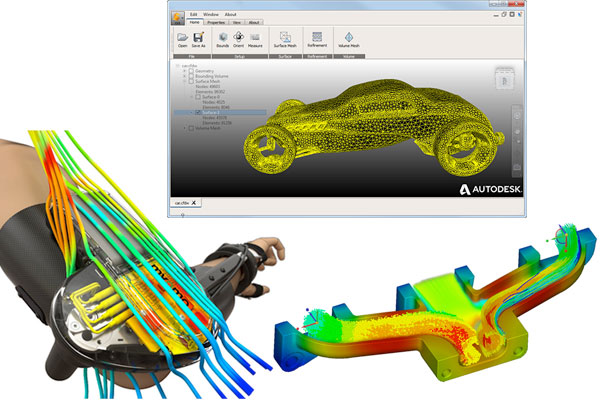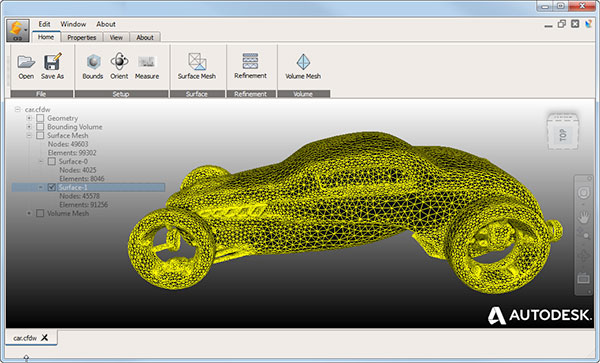CAD Embedded CFD: Overhyped, but a Good Value for Some
A look at using SolidWorks Flow Simulation from Dassault Systèmes, Inventor's Autodesk CFD and ANSYS Discovery Live for computational fluid dynamics.

Images courtesy of MyoPro from Myomo, Inc., Autodesk and ANSYS (left to right).
Latest News
December 14, 2018
While pushing simulation forward in the design cycle is a noble concept that has the potential to reduce costly engineering change orders, getting there is not as simple as making computational fluid dynamics (CFD) analysis available to designers within the 3D CAD interfaces they are familiar with. A direct CAD interface with CFD in and of itself does not provide any new or improved solutions to the biggest challenges of CFD simulation, i.e., geometry simplification and cleanup, extracting the fluid region from what is typically a 3D model of the solids involved, ensuring simulation accuracy through high-quality meshing, and CFD process quality controls. However, one particularly beneficial aspect of CAD-embedded or CAD-linked CFD that should be noted is its potential for enabling and streamlining parametric studies.
Our original article looks in detail at two leaders in this market segment: SolidWorks / Flow Simulation from Dassault Systèmes and Inventor / Autodesk CFD from Autodesk and discusses newcomer, ANSYS with its Discovery Live.
Example #1: SolidWorks Flow Simulation
SolidWorks Flow Simulation may be considered the most “CAD embedded” CFD program in this class. The basic interface and workflow is organized logically, and SolidWorks Flow has grown in capabilities over the last decade. Overall, the process of 3D CAD model cleanup and preparation with SolidWorks Flow is very similar to that which you would use if you were exporting to a neutral file format for import into a stand-alone CFD package, but meshes tend to be of average to poor quality, requiring a higher number of cells to achieve the same accuracy as lower cell-count, higher quality meshes produced with some of the other tools available.

For simulations, SolidWorks Flow uses a finite volume solver, which we’ve found to be rather inefficient. The post-processing, while not spectacular, does benefit from being embedded in SolidWorks with its refined visual approach to presenting 3D information. At last check, a node-locked, perpetual Flow Simulation license could be purchased for around $14,000.
Example #2: Autodesk CFD
Although Autodesk CFD is not technically CAD embedded, it still qualifies in this category because connectivity between simulation files and the original 3D CAD model can be maintained by following the correct procedures. The workflow in Autodesk can be a bit broken up, but it is, in general, much the same as in SolidWorks. The software does an adequate job of covering most of the basics including the ability to model multi-component fluids or gases, steady or unsteady flows, a built-in material database, and decent pre-and post-processing tools.
Because Autodesk CFD is finite element based, surface meshes are triangular and volume elements are by default tetrahedral. The standard meshing tools allows for slider bar mesh density assignment, much the same as with SolidWorks, and attempting to refine individual surfaces or regions is messy though possible. Prismatic layers in the boundary layer of solid surfaces can be achieved with the “wall layer” option activated.

One nice mesh-related feature available is a surface wrapping tool that can be used to define the domain for external flow simulations, i.e., wind tunnel tests. As far as simulating, Autodesk CFD is somewhat of an outlier in the CFD community as it employs a finite element solver. Our trials have confirmed that Autodesk CFD is much slower than the best-in-class FV solvers and marginally slower than SolidWorks Flow Simulation, when run on comparable computational meshes. Autodesk CFD post-processing is a little like being transported back in time about 10 years compared to the best-in-class tools. Currently, Autodesk CFD Premium and CFD Ultimate are available as annual subscription for around $9,500 and $11,600.
Example #3: ANSYS Discovery Live
I have to admit, I was shocked when I first saw a Discovery Live demo by how out of character the product and the roll-out was for ANSYS. I had been transported into an alternate universe where ANSYS, the company who says “to get serious CFD results, you need serious software,” was unabashedly hyping and releasing an unvalidated software with the new call-to-action “utility over accuracy.” Simulation was to be fun again.
There are two aspects that attract me to Discovery Live. First, all Discovery Live simulations are inherently time-dependent and naturally result in appealing and intuitive flow visualizations showing unsteady behavior. The second thing that grabs me is the ease with which a modification to a geometry can be introduced into the simulation. This capability is, at its worst, a novel and beautiful use of direct 3D modeling technology and, at its best, a disruptive breakthrough that will be a model for all future CFD programs. Since this technology is so new we won’t go through the workflow analysis and will, instead, show you a live demo to spark the imagination. For those of you not willing to wait for clarity, Discovery Live can be had at the very reasonable price of $3,000 for an annual subscription, and you’ll need a pretty nifty GPU card to make it go.
For a more detailed review of SolidWorks Flow Simulation, Autodesk CFD, and Ansys Discovery Live, including basic interface and workflow, physics modeling capabilities, CAD cleanup and meshing, simulating, and post-processing, read the original article on our blog.
If you are a CFD software user, consider participating in our CFD User Survey.
For More Info
Stewart Bible and Caleb Triece are co-founders and managing partners of Resolved Analytics.
Subscribe to our FREE magazine, FREE email newsletters or both!
Latest News






